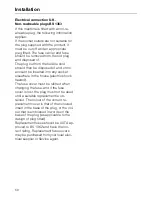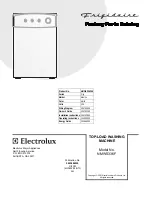
What to do, if . . .
Cause
Remedy
. . . large residues of deter-
gent remain in the dispenser
drawer.
The water supply pressure is
too low.
–
Clean the filter in the water
inlet system.
–
It may be useful to select
“Water plus”.
Washing powder used with
water softener tends to become
sticky.
Pour washing powder into the
dispenser before adding any
water softener.
. . . fabric conditioner is not
completely dispensed or too
much water remains in the
p
compartment.
The siphon tube is either
incorrectly positioned or
clogged.
Clean the siphon tube.
The fabric conditioner channel
is clogged.
Clean the fabric conditioner
channel.
. . . grey, greasy particles
cling to washed laundry.
Insufficient amounts of
detergent were used to break
down the particles of grease in
heavily soiled laundry.
–
Add more detergent.
–
Before washing the next load
run a “COTTONS 95°C”
programme without a load.
(See "Extra cleaning" in
Cleaning and Care).
. . . there are white residues
which look like powder deter-
gent on the washing.
The detergent contained
compounds (zeolites) to aid
water softening which are not
soluble in water. These have
ended up on the washing.
–
Use detergents containing
no zeolites to re-wash the
load.
–
Liquid detergents usually
contain no zeolites.
–
Try and brush off the
residues with a soft brush.
. . . liquid detergent does not
give the required result.
Liquid detergents do not
contain bleaching agents. They
do not remove fruit, coffee and
tea stains.
–
Use a general purpose
washing machine powder
containing a bleaching agent.
–
Pour stain remover (salts)
into the dispenser drawer
compartment
j
, and liquid
detergent into a dispenser
ball.
–
Never put stain salts and
liquid detergent together in
the dispenser drawer.
Problem solving guide
46
Содержание W 828
Страница 59: ...59 ...















































